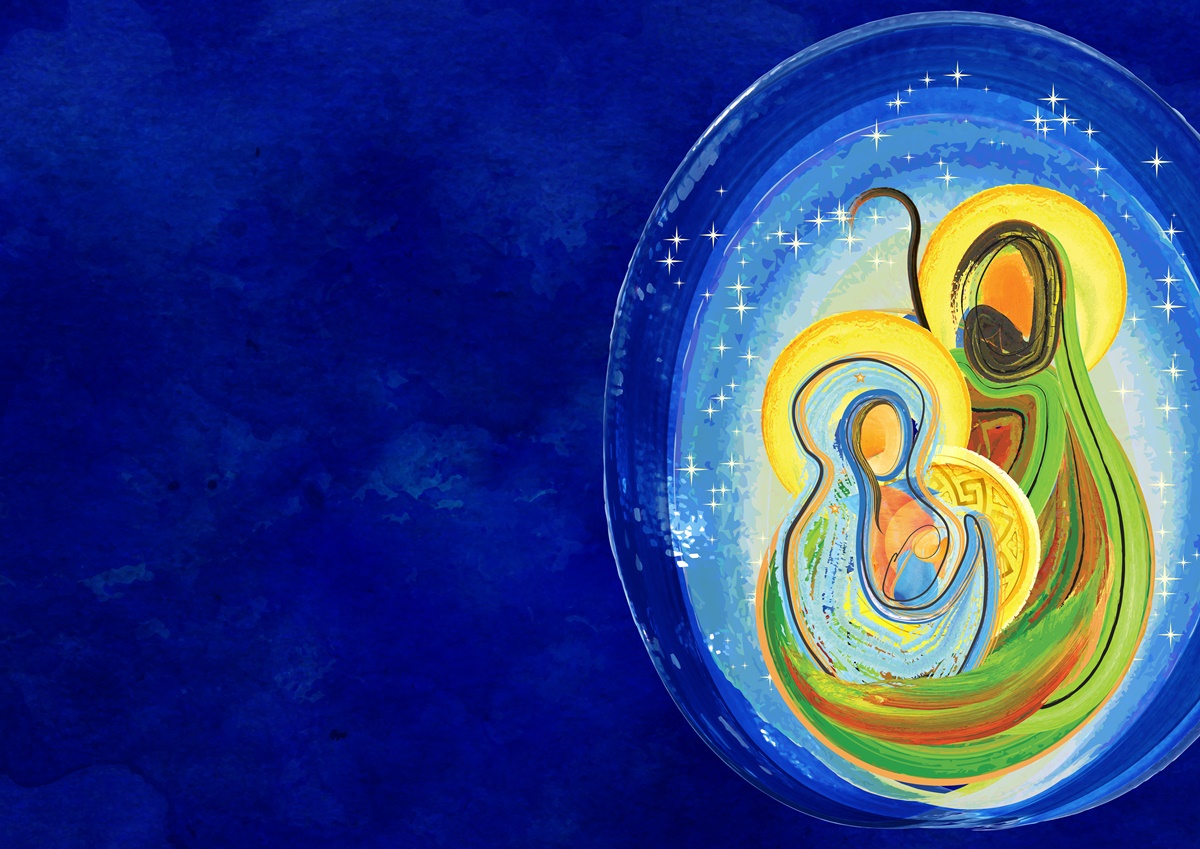The feast of the Holy Family, which is situated appropriately between Christmas and New Year’s Day, serves as a context for the events it bridges: the birth of Christ and the octave of Mary.
As the humanity of Jesus is our path to the Father, remembering the family of Jesus is a fitting way to end and begin a year. When we recall that Jesus is Emmanuel — God with us — we are sustained in our darkest hours, and are able to find hope and joy. It puts our whole life in perspective. As we treat ourselves and others, so we treat him (see Mt 25:40; 45).
In their Gospels, evangelists Matthew and John most profoundly emphasize Jesus as the Word made flesh, and they also stress that it’s love of the Church, and particularly its most vulnerable members, that is the determining factor in the final judgment. The epistles of James and Paul likewise echo this perspective. This most profound theological concept is realized in the foundational moral concept of love of neighbor and self, and this unity is a hallmark of biblical and Catholic teaching.
Living in a loving manner sometimes can be most difficult within the family (the domestic Church), where intimate conflicts yield deep wounds, and where routine and familiarity can breed contempt and complacency. So we look to the Holy Family as models of fraternal love in a world of fractured family life and institutions.
Embracing the Holy Family
To best learn how to live as the Holy Family did, we must incorporate Jesus, Mary and Joseph into our lives through affection. As within our own families, analysis and reason are insufficient when it comes to enduring trials. Only love, supplemented by faith and hope, will suffice. As human beings, love is a choice that we are always free to make. Thus the Gospels and the Church, particularly in her liturgy, stress Jesus’ total freedom in giving his life for us.
Embracing the Holy Family means accepting them as they are — and ourselves as well. We (re)discover the Holy Family through the process of lectio divina on the Scriptures, by which we invite them into our lives and open ourselves to the Spirit. Traditional devotions such as the Rosary and the Stations of the Cross are proven ways of entering into the mystery. We embrace them as we would a family member, and in a different way they are no less challenging. They long to become a part of us, related by adoption through human and divine choice. The feast of the Holy Family is a wonderful time for Catholics across the theological spectrum to renew their devotion to them.
Devotion to the Holy Family and love of family are complementary practices as the former is the model of the local and universal human family. Embracing the Holy Family means entrusting ourselves to them like a child, in the manner proposed by Jesus (cf. Lk 18:16-17). Through emulation in prayer, service and obedience, we cultivate this enthusiastic disposition.
Emulating the Holy Family
Every modern papal document addressed to women urges emulation of Mary. St. Joseph, because he is the model disciple in St. Matthew’s Gospel — and patron of families and the universal Church — also is worthy of emulation by both genders. Emulation requires adoption of positive habits and behavior patterns, which then must be supplemented by conducive lifestyle choices. Since Pope Pius XII, every pope has emphasized the importance of making prudent use of the communications and entertainment media.
In a memorable address on April 16, 1969, Pope Paul VI said: “We can pass from the position of mere observers to that of critics, thinkers, judges. This attitude of reflective knowledge is of the greatest importance for the modern soul, if it wishes to remain a living soul, and not just a screen for the thousand impressions to which it is subject. … The discovery of the signs of the times is a fact of Christian conscience.”
In accordance with Paul VI’s 1966 apostolic constitution on fast and abstinence, Paenitemini, and of John Paul II’s 1998 apostolic letter on the Lord’s day, Dies Domini, perhaps on these sacred bookends to the week we can remember the Holy Family in a special way — such as through prayer, charitable actions or renewed efforts to accept divine providence — or by reflecting on a papal document concerning Jesus (e.g., Redemptor Hominis, “Redeemer of Man,” John Paul II’s first encyclical), Mary or Joseph. How necessary it is to supplement embrace of the Holy Family with prayerful and reflective adoption of their attitudes and dispositions, however imperfectly.
With the Christian joy that comes from a beatitudinal lifestyle, surely reminiscent of that of the Holy Family (see Paul VI’s May 1975 apostolic exhortation Gaudete in Domino, “On Christian Joy”), we will then be able to celebrate and relate more deeply to the Holy Family, who endured and transcended the struggles and tragedies of life through obedient abandonment to divine providence (see Jesuit Father J.P. de Caussade’s spiritual classic of that name).
Reflection on Scriptural accounts of the Holy Family aided by reading between the lines and common sense inferences will remind us that the struggles we undergo are anticipated in them. Dealing with a miraculous virginal conception and the social responses it surely engendered, marital celibacy (unprecedented and baffling for Jews and arduous for any couple), poverty, ostracization, death threats, a refugee beginning, confusion, painful misunderstandings and loss (Joseph’s death) gives them first-hand familiarity with the trials we endure. They are our unparalleled advocates, and the consolation and reassurance they offer us amid our crosses is a supreme grace. May we turn to them amid our struggles, confident of their loving and efficacious support.
Today’s culture
We live in a culture that is making war against the family. In response, the Church invites us to cultivate family life as a domestic Church marked by prayer, liturgical worship, dialogue, recreation, and mutual service and forgiveness. To live this calling, we need frequent reminders of the seminal domestic Church, the Holy Family. Thus we celebrate them liturgically as a sacramental way of inviting them into our hearts and homes — not as plastic, remote, angelic figures, but as flesh and blood persons who understand our struggles and forever intercede for us.
The Bible offers many guidelines for family relationships. Most are counter-cultural. Gender-specific injunctions are regarded by some within the Church as culturally conditioned and therefore obsolete.
In offering Mary to us as an example in his 1974 apostolic exhortation Marialis Cultus, Paul VI reminds us that it is not the cultural accoutrements that are binding, but the underlying dispositions and actions. Mutual submission in service. Distinctive orientations according to our vocational roles. Self-giving love in the mold of the Holy Family — the key participants in the history of salvation.
Venerable Fulton Sheen inscribed “JMJ” in remembrance of the Holy Family whenever he wrote religious reflections and instructions. However we remember them, let it be born out in prayer and action as we derive from them courage and comfort.



